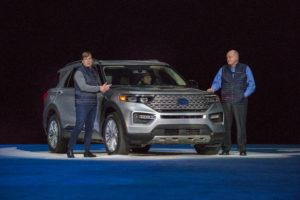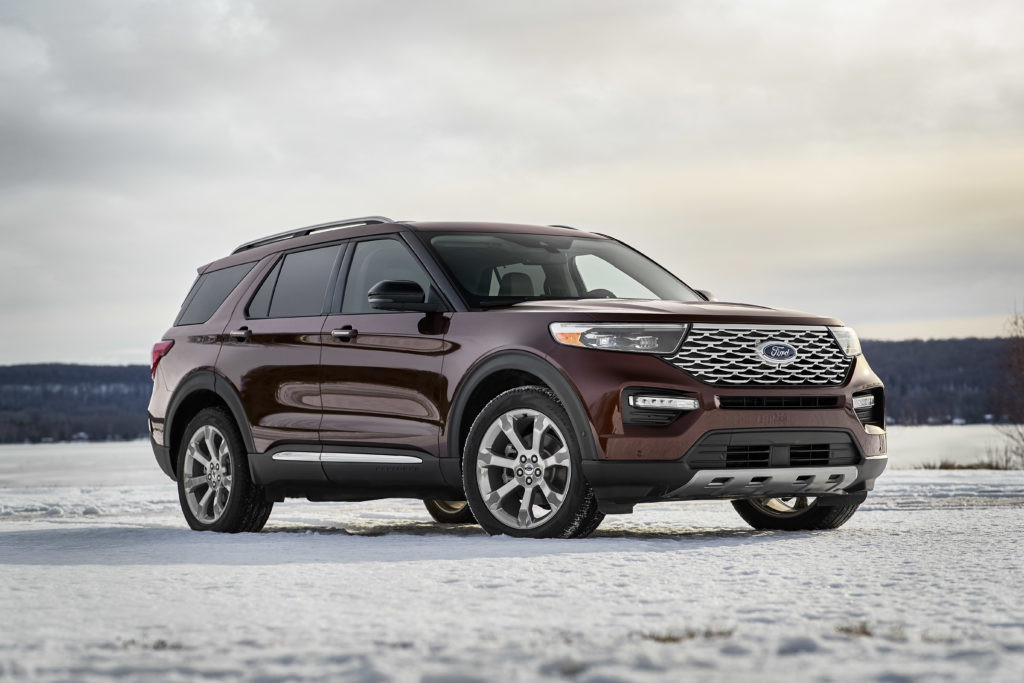
Ford: Next-gen Explorer 200 lbs. lighter, but mostly steel; ADAS suite standard
By onMarket Trends | Repair Operations | Technology
The next-generation 2020 Ford Explorer shed 200 pounds when its XLT trim is stacked up against the prior generation’s, but achieved this largely without relying on the aluminum for which the OEM has recently been known.
Ford Explorer vehicle engineering manager Scott Slimak said at the North American International Auto Show on Monday that the next-generation Explorer was about 25 percent high-strength steel, including some boron steel. He couldn’t provide more detail about the specific breakdown of steels, so it’s unclear if this tally was a reference to more advanced grades of high-strength steel, with lower-tier high-strength steels comprising even more of the vehicle.
He said some ask if Ford just bought the weight by shifting parts to aluminum (which can be more expensive than steel). However, while some aluminum existed on the Explorer and Ford made extensive use of high-strength steel, much of the weight savings came from “good, hard engineering,” according to Slimak.
Ford eked out mass savings through techniques like optimizing bolt lengths and cutting “lightening holes” in some parts, including the battery brackets in the hybrid Explorer variant, he said.
Slimak said the OEM used aluminum in the hood and front shock towers. Working on these parts will still probably require dedicated tools and space like you’d need for a predominantly aluminum F-150.
He said Ford was proud it didn’t just buy its way to reduced mass, and he said that to him the “cool thing” was Ford’s ability to “pack more towing, get the four-wheel drive in. ‘The and, and, and,’ right? And all the new features and technologies, and still take out the weight.”
The 2020 Explorer goes on sale this summer. Ford sold 227,732 last year.
Another critical element for repairers to watch will be the ADAS suite Co-Pilot360 coming standard. It includes autobraking, including with pedestrian detection; lane keeping; blind spot checks; rear-cross traffic alerts; and automatic high beams.
More options include post-crash braking and steering help to avoid a collision. (The latter doesn’t actually autosteer the car; instead, it helps apply force if the driver’s swerve wouldn’t have enough power to avoid the obstacle.)
“It’s not about filling the vehicle with technology for technology’s sake,” Ford Co-Pilot360 engineering manager Chris Billman said in a statement. “It’s about improving the experience, making driving less stressful, and helping the driver to feel more confident behind the wheel.”
Other ADAS to watch:
- Auto parking is available as an option and standard on the Platinum Explorer trim.
- Rear autobraking also exists as an option, coming standard on the Platinum trim.
- A new adaptive cruise control option can recognize speed limit signs and adjust the speed accordingly.
Other items possibly of interest to collision repairers:
- The Explorer kept “blacked-out A-pillars and D-pillars and body-color C-pillars.”
- The Platinum trim has “door handles with satin aluminum insert, liftgate appliqué, lower bodyside cladding insert, roof-rack side rails and a unique grille with satin aluminum finish” and a two-panel moonroof.
- Seven wheel options are available as well as the base 18-inch aluminum rims.
- FordPass Connect comes standard and works if the driver has “a compatible wireless subscription service,” according to Ford. It includes the ability to “monitor key vehicle diagnostics,” Ford wrote in the news release.
- A hybrid variant exists. “Unlike previous hybrid vehicles, a specially designed liquid-cooled lithium-ion battery is built into the Explorer chassis below the second-row seats to preserve cargo and passenger space,” Ford wrote in another news release.
- The headlights on at least the ST and Limited hybrid versions say “Explorer,” which could make aftermarket copies a harder sell for a customer.
More information:
Ford, Jan. 9, 2019
“ALL-NEW FORD EXPLORER GOES FASTER AND FURTHER WITH PERFORMANCE-TUNED ST AND NO-COMPROMISE HYBRID”
Ford, Jan. 14, 2019
2020 Ford Explorer Co-Pilot details
Images:
Ford global markets President Jim Farley, left, and CEO Jim Hackett show the 2020 Ford Explorer on Jan. 9, 2019. (Provided by Ford)
The 2020 Ford Explorer Platinum is shown. (Provided by Ford)
A 2020 Ford Explorer Limited hybrid’s headlight is shown. (John Huetter/Repairer Driven News)


